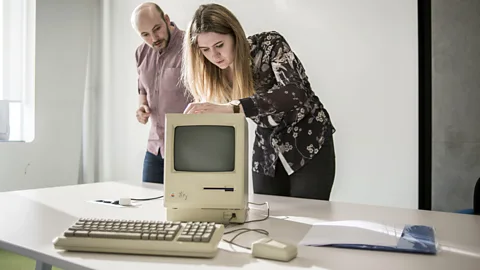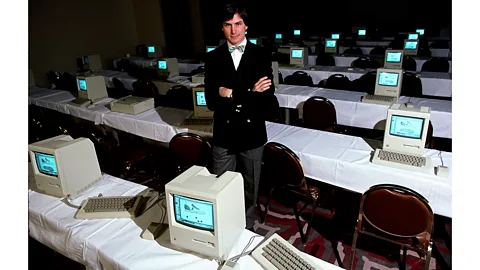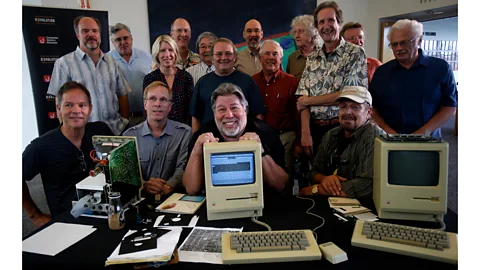The Apple Macintosh was first released 40 years ago: These people are still using the ageing computers
 Alamy
AlamyOn 24 January 1984, the Apple Macintosh 128K personal computer was unveiled to the world, but 40 years later it still has a loyal following of fans – and users.
David Blatner still has practically every Macintosh computer he ever bought. But one in particular stands out – the first. He remembers the neat way the screen was laid out; the glossy manual; the cassette tape tutorials explaining how to use the machine. It was everything he felt a computer should be.
He had seen early iterations of personal computers as a young child. He used to ride his bicycle to Xerox's Palo Alto Research Center in California where his stepfather worked in the 1970s. There, Blatner got to try early personal computers such as the Alto, which had a graphical interface and a mouse.
"A computer that would work for a single person – that was, in itself, mind-boggling," remembers Blatner, who is now president of CreativePro Network, an online resource for creative professionals.
But it would take another decade before he got one of his own – with the arrival of the Apple Macintosh.
On 24 January 1984, a man called Steve Jobs got up on a stage and heaved a beige box out of a carrying case, shoved a floppy disc into it, and stood back. As the theme from Chariots of Fire played, the word "Macintosh" swept across the tiny computer's screen and a series of monochromatic images flashed up. The captivated audience – of Apple shareholders – went wild.
By today's standards, the tiny screen, boxy form and rudimentary graphics of the original Macintosh look ludicrous. The device was not even the first personal computer. But it was, arguably, the first to change the world. And Steve Jobs’ flashy launch day presentation, at the Flint Center in Cupertino, California, became a template for his many later appearances introducing subsequent Apple hardware – including the iMac and iPhone.
Today, the Mac 128K – so called because it came with 128kb of Random Access Memory, or RAM – is a museum piece. Apple stopped producing the computers in October 1985 and discontinued software support for them in 1998. But a handful of diehard fans still use their Mac 128K computers today – although not without frustrations. The machines are extremely limited due to their small amount of memory. If you want to check out the 128K's specifications, Apple actually lists them on its website.
Even with its diminutive memory, no modem or ability to connect to the internet, and rudimentary graphics, there is a community of avid fans who delight in poring over this seemingly ancient hardware. David Greelish, a computer historian in Florida who is releasing a documentary about the 128Ks predecessor the Apple Lisa this month, notes the ingenuity of the 128K's original circuit board. "It's got everything: ROM, RAM, processor and all the input-output," he says. "Everything there in a beautiful little integrated square board. For 1984, it was amazing."
 Getty Images
Getty ImagesThe original Macintosh can still sell for as much as a modern computer. And for collectors they are a piece of computing history, with the signatures of the team who built it moulded into the plastic of the rear casing.
Some Mac 128K owners, however, use the devices to play quirky games like Frogger or Lode Runner on their treasured machines. All in black and white. The first Macintosh with a colour screen, the Macintosh II, only arrived in 1987.
The Centre for Computing History in Cambridge, England, is one of many collections that feature a functioning 128K. "It’s 40 years old and it’s still going," says Lisa McGerty, chief executive, who remembers the introduction of Macintosh computers as a "massive" improvement for people in the printing and publishing business. Apple's graphical printer, the ImageWriter, was released shortly before the 128K.
McGerty’s colleague Adrian Page-Mitchell, collections officer, says it’s not always easy to keep these decrepit Macintoshes functioning. An earlier 128K that had been on display for a long time at the Centre for Computing History eventually failed and "couldn't be fixed", he says.
Sometimes Macs show their age in strange ways. Steven Matarazzo, a YouTuber and computer collector, says that one of the machine’s capacitors can sometimes degrade over time, meaning that the 128K's screen won’t work properly – it'll appear slightly squished.
Last year, he published a YouTube video about an apparent prototype version of the 128K that turned up. It wasn't working so its owner asked Matarazzo if he could take a look at it. Before long, Matarazzo had the device functioning again. He studied every inch of this early Mac in detail, enthusing about tiny differences between it and the version that made it to market – such as the little Apple logos imprinted on the rubber feet of the prototype. Those weren’t there in the final design. It’s a bit like archaeology for gadgets, he explains.
"You try and put this together – what was the process here, how early was this, how late was this?" he says. "That is, especially to me, what is really cool."
The Apple II and the Apple Lisa, which predated the 128K, were also intended as intuitive, highly capable devices. But each had their own flaws or limitations – the Apple II did not come with a graphical user interface or mouse and the Lisa was much less affordable compared to the 128K, for instance.
By the time the 128K launched, Blatner was finishing high school and looking for a computer to take to college – something as capable as those machines he'd seen at Xerox years before. His parents took him shopping and they soon found a 128K on display at a shop in downtown Palo Alto.
"It had menus, it had folders, it had a graphical user interface, it had a mouse – it was everything I thought a computer ought to be," he recalls, adding that he still has the receipt. The device cost his parents $2,495 and, at college, Blatner was soon showing it off to his fellow students. They used to queue up behind him in his dorm for a chance to try the computer out. "I have a file cabinet with all these crazy things we were printing out at college," he says. "People just loved it."
It was no coincidence that this technology echoed Blatner’s earlier experiences with computers at Xerox. Jef Raskin, who initiated the Macintosh project – and named the computer after his favourite variety of apple – had also seen the same Xerox technology and been inspired by it. Not only that, in December 1979, Jobs and a handful of Apple engineers toured Xerox multiple times. This gave them ideas that would later shape both the Lisa and Macintosh. In exchange for those impactful demonstrations, Xerox received a large volume of Apple shares, which they quickly sold, losing out on potentially billions of dollars had they held onto them.
Famously, Jobs ended up taking over the Macintosh project started by Raskin after getting kicked off the Lisa team. By this point, Jobs had developed a vision for an affordable personal computer and he decided that the Macintosh would help him make it a reality.
Among the things that made Macintosh different was its presentation. It wasn't just a personal computer, it was a computer with personality. Susan Kare, a graphic designer, came up with cartoon-like icons that practically anyone could understand, and she also contributed to the Macintosh’s collection of digital fonts.
 Getty Images
Getty ImagesBut so much about the Mac and the splash that it made was fuelled by marketing and hype. Jason Scott, a filmmaker and historian of technology who works at the digital archive non-profit Internet Archive, remembers seeing the original TV ad for the Mac 128K as a teenager. The bizarre short film was directed by Ridley Scott and depicted a dystopian future inspired by the novel 1984. What would save us all from that dark future? The Mac 128K, of course.
"That commercial began playing and it seemed like it was completely from Mars," recalls Scott. "Something was going on but I didn't quite understand it."
Not long after, when Scott tried a Macintosh for the first time, he was enraptured. It was, he says, like looking through a telescope to another world.
And yet the Mac was not as big a success as some expected. "It didn’t sell to businesspeople like Steve thought it would," remembers Andy Cunningham, who worked on the marketing campaign for the device. "It’s ultimately why Steve got fired from Apple." Jobs left in 1985 but returned to the company in the late 1990s.
It took until 1988 before Apple had sold enough Macintosh devices, including various subsequent iterations of the original Macintosh, to finally eclipse sales of the Apple II, which had come out way back in 1977.
But Macs did appeal to many, especially young people and those working in creative roles.
Cunningham and her colleague Jane Anderson helped to pump up hype over the original Macintosh by offering individual journalists six hours each with people at Apple, including Jobs, and giving them multiple demonstrations of the machine to ensure that they understood what they were writing about. "I watched them all play with this computer and their eyes just glistened," says Cunningham.
It would be wrong to suggest that the Mac 128K was a perfect computer. As mentioned, it had severe limitations and was hardly a commercial hit at first. But it left an indelible mark. The rise of personal computing was undoubtedly a watershed moment. The ridiculously oversized, cabinet-like computers that you could only plug into via a clunky terminal now seemed hopelessly antiquated. Now we had portable, cheerful, accessible machines that almost anyone could use.
Funnily enough, the era of individualised computing heralded by the original Macintosh is, in one sense, coming to an end. In the 21st Century, we are becoming ever more dependent on server farms, cloud processing, big data, and networked systems. Other people’s computers are increasingly indispensable for running our own.
"We are now on the other side," reflects Blatner, who has kept almost every Macintosh he ever bought. "We did need this 40-year period of enabling people, of empowering people."
--
If you liked this story, sign up for The Essential List newsletter – a handpicked selection of features, videos and can't-miss news delivered to your inbox every Friday.
